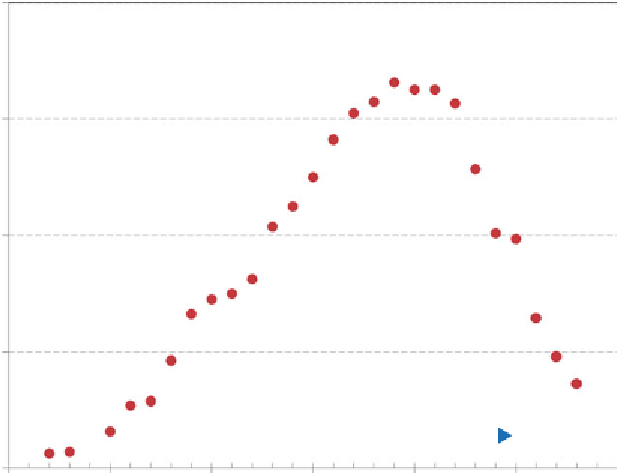Biomedical Engineering Reference
In-Depth Information
4
3
1995: Year-round reformulated
gasoline program starts
2
1992: Winter oxyfuel
program starts
1
MTBE phased out of
reformulated gasoline
0
1980
1985
1990
1995
2000
2005
2010
Year
Figure 10.1. MTBE production rates in the United States from 1982-2008 (EIA,
2008
).
Aquincola tertiaricarbonis
L108,
Mycobacterium austroafricanum
IFP 2012 and
Hydrogeno-
phaga flava
ENV735), while others cometabolically oxidize MTBE using alkanes or alcohols as
cosubstrates or fortuitous inducers of ether metabolism (e.g.,
Mycobacterium vaccae
JOB5,
Pseudomonas mendocina
KR-1). Direct MTBE degraders exhibit low biomass yields (0.09-0.44
grams (g)-biomass/g-MTBE) and slow specific growth rates (0.2-0.5/d) (Fortin et al.,
2001
;
Fiorenza and Rifai,
2003
; Davis and Erickson,
2004
) compared to higher energy substrates like
alkanes, alcohols, ketones and sugars (with apparent yields of 1-1.5 g-biomass/g-carbon
utilized) (Salanitro et al.,
1998
).
Cometabolic degradation initially appeared attractive because it decouples the biodegrada-
tion of contaminants from microbial growth (i.e., the organisms can be grown on a relatively
harmless substrate such as propane, while fortuitously degrading MTBE). However, cometabo-
lism was found to lead to the accumulation of TBA, which is also a compound of concern at low
m
g/L concentrations (Nava et al.,
2007
). Some direct degraders are associated with the buildup of
TBA, while others appear capable of complete mineralization (McKelvie et al.,
2007
).
The slow growth rates and low yields of ether-degrading organisms compared to benzene,
toluene, ethylbenzene and total xylenes (BTEX) degraders, with biomass yields of 0.5-1
g-biomass/g-BTEX and growth rates of 1-6/d (Yerushalmi and Guiot,
1998
; Kelly et al.,
1996
;
Salanitro,
1993
; Wiedemeier et al.,
1995
) explain why MTBE plumes tend to outlive those of
their co-occurring fuel components. The low cell yields on MTBE and other tertiary butyl ethers
like
tertiary
amyl methyl ether (TAME) and ethyl
tertiary
butyl ether (ETBE) is a biochemical
limitation potentially affecting the consistency and completeness of ether degradation in
groundwater plumes. The slow growth rate and low yields of indigenous degraders in aquifer
sediment can make it difficult to sustain natural bioattenuation processes for long term plume
management, perhaps even with sufficient nutrient addition and oxygenation.









































Search WWH ::

Custom Search